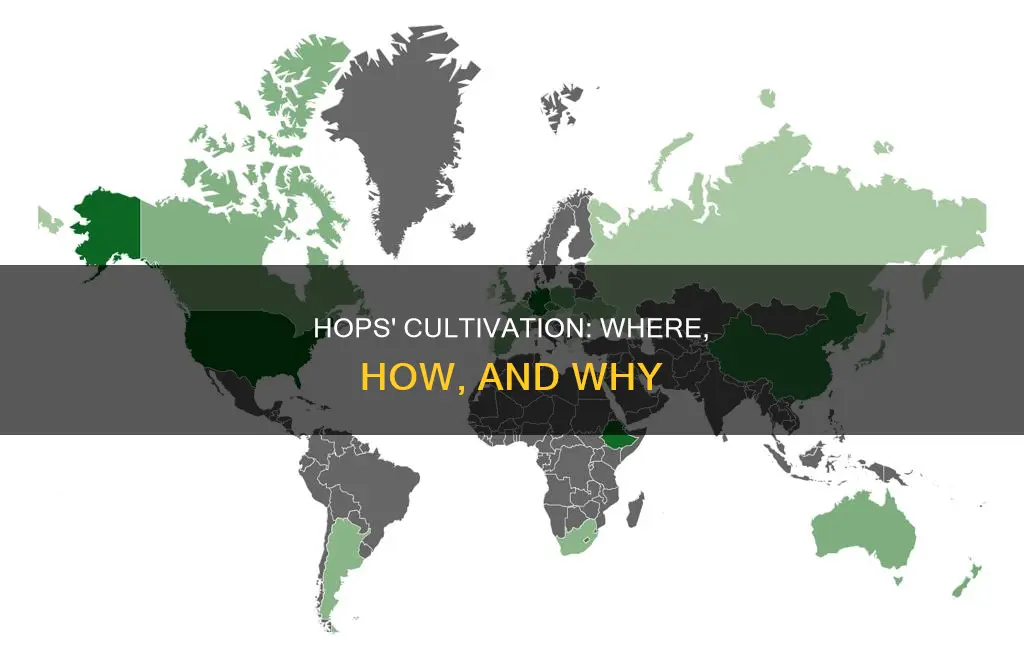
Hops, the flowers of the humulus lupulus plant, are an essential ingredient in beer. They grow best in moderate climates, between the latitudes of about 35 and 55 degrees, which includes the northern US and most of continental Europe. Hops have a preference for long days, hot summers, and cold winters, and they require rich soil and plenty of sunlight to thrive. Commercial hop cultivation began in Northern Germany during the late 1100s, but the earliest recorded use of hops in beer was in 822 in Northern France. Today, the US is the world's largest hop-producing country, with Germany coming in second.
What You'll Learn

Hops grow best in moderate climates
Hops, the key ingredient that gives beer its distinctive bitter taste, thrive in moderate climates. While they can be grown in most areas of North America, certain varieties are better suited to specific climates. For example, the Chinook variety grows well in dry, hot climates and makes for a great ornamental hop, whereas Fuggle, a variety that grows well in damp climates, struggles a little in hot climates.
Hops grow best in temperatures between 40 and 70 degrees Fahrenheit. They require a lot of water and can be invasive, similar to morning glories. In addition, they are very fast-growing, with growth spurts of up to a foot per day during the summer. Hops also require a significant amount of sunlight, with 15 hours or more of sunlight per day being ideal. They also need rich soil to grow in.
To support their rapid growth, hop plants need to be nurtured with frequent, light waterings. The goal is to provide enough water for the plant to establish its roots without causing the rhizomes to rot. Once the shoots break through the soil surface, growth accelerates, and the plant will quickly need additional support to continue climbing. Commercial hop farms use tall trellises, which can reach up to 20 feet in height, to support the weight of the mature plants.
While hops can be grown in many parts of the world, commercial production requires optimal conditions. Land between the 35th and 55th parallels offers the ideal combination of temperature, precipitation, and sunlight for hop cultivation. This is reflected in the locations of the top hop-producing countries and regions, such as the Pacific Northwest of the United States, Hallertau in Bavaria, and the Xinjiang region of China.
Hops in Beer: Understanding the Magic Numbers
You may want to see also

Commercial production requires optimal conditions
Commercial hop production requires optimal conditions to ensure the highest crop quality is maintained. While hops can be grown in a variety of climates and locations, there are certain conditions that will help them thrive.
Firstly, hops grow best in moderate climates with temperatures ranging from 40 to 70 degrees Fahrenheit. They also require long, frost-free summer days, with over 15 hours of sunlight, and winter temperatures below 40 degrees Fahrenheit for one to two months. This means that most commercial hop production occurs between 40 and 50 degrees latitude, or between the 35th and 55th parallels. Regions that fit within these latitudes include the Pacific Northwest of the United States (Washington, Oregon, and Idaho), Hallertau in Bavaria, Germany, and the Xinjiang Region of China. These regions produce the majority of the world's hops.
In addition to the right temperature and sunlight conditions, hops also require specific soil and irrigation conditions. Hops grow best in well-drained, deep, sandy loam soils with a pH of around 6.5. They also require supplemental water and nutrients to ensure ample plant growth and the full development of the chemical compounds in the cones used for brewing. Michigan State University recommends at least 6 gallons of water per plant per day during the peak growing season in June and July.
To maintain optimal conditions, growers must also monitor their plants for pests and diseases, such as downy and powdery mildew, mites, aphids, and leafhoppers. Proper pruning and training of the bines are also essential to improving plant vigour and reducing disease pressure.
By ensuring that these optimal conditions are met, commercial hop producers can achieve excellent yields and maintain the high quality demanded by the brewing industry.
Kegging Beer: Reducing Hops for a Balanced Brew
You may want to see also

Hops require rich soil
To achieve the ideal soil conditions for hops, you can add rich organic matter such as compost or manure to the top few inches of the soil. If your soil is sandy, blend in organic matter and peat moss, aiming for a 45/45/10 mix of sand, organic matter, and peat moss, respectively. If your soil is primarily clay, blend in organic matter, peat moss, and sandy topsoil to loosen it up. A sand percentage of around 20-25% is ideal.
It is also important to test and adjust the pH level of your soil. If it is too acidic (below 6.5), you can use powdered limestone or wood ash to raise the pH. If it is too alkaline (above 8.0), ground sulfur, peat moss, sawdust, or oak leaves can bring the pH down.
Additionally, hops require a significant amount of nutrients, so the soil should be rich in key nutrients like potassium, phosphates, and nitrogen. You can add rock phosphate to your soil, which is a great source of minerals that are slowly released over time. Regularly adding compost or manure to your soil will also help ensure that your hops receive the necessary nutrients.
Overall, preparing and maintaining rich soil is essential for the successful growth of hops.
Hemp and Hops: Exploring the Botanical Cousins
You may want to see also

Hops are picky about where they'll grow
Hops are indeed fussy about where they'll grow. They are a hardy plant, but they do have specific requirements for optimal growth.
Firstly, hops thrive in moderate climates, between 40 and 70 degrees Fahrenheit. They can tolerate a wide range of precipitation, from 12 to 53 inches of rain per year. However, they are particular about sunlight, requiring over 15 hours a day, and frost-free days to mature. They also prefer a south-facing location, with good drainage, and slightly elevated ground.
The soil is an important factor in the successful cultivation of hops. Hops need rich, loamy, and well-drained soil with a pH between 6.0 and 7.5. The pH level is crucial as it directly affects the nutrients available to the plant. If the pH is off, it can lock up the soil and prevent growth. Hops also require frequent, light watering to help the plant establish its roots.
Hops are a sun-loving, vigorous plant, and they grow vertically, requiring plenty of space. They can grow over 20 feet in a year, so they need a sturdy support system. They climb clockwise, using tiny hairs to attach to strings, trellises, fences, or the side of a building.
Hops are grown commercially in many countries, but the top producers are the United States, Germany, and China. The best locations for commercial production are between the 35th and 55th parallels, where conditions are optimal.
Hops and Hormones: The Estrogen-Beer Link Explained
You may want to see also

Hops are grown in the southern hemisphere
Southern Hemisphere hops have played a huge role in helping brewers create beers that meet consumer demand for juicier IPAs and beers. According to The State of Hops report from First Key Consulting, "one of the first flavour hops was the New Zealand-bred Nelson Sauvin, named for the city around which it is cultivated and the Sauvignon Blanc-like aromas and flavours it produces". The report continues, "these hops allowed brewers to craft bold flavours and aromas with or without their associated bitterness".
In Australia, the most in-demand hops include Nelson Sauvin, Riwaka, and Australian Galaxy, which tend to be higher in alpha acids, allowing brewers to focus more on flavour impact. In 2022, Hop Products Australia (HPA) reported a 12-year continuous growth, with a net increase of 8.8% in their hop harvest. HPA recently completed a $35 million capital expansion project to plant 300 new hectares of Aussie flavour hops, including Eclipse®, Galaxy®, and Vic Secret™.
In New Zealand, an $8.5 million investment in 2018 has helped take the country's hop breeding and growing to new heights. NZ Hops Ltd. reported a record-breaking harvest in 2020, collecting 1,231,936 kilograms (2.7 million pounds) of hops, an 18% increase from the previous year. American brewers have gone crazy for Nectaron, a nascent hop that came to market last year after a 17-year collaboration with New Zealand's Plant & Food Research. Brewers have praised Nectraon for its intense pineapple, passion fruit, peach, and grapefruit qualities, making the hop perfect for hazies, IPAs, and pale ales.
Southern Hemisphere hops are hot right now, and with new varieties coming online, their influence is only expected to grow.
The Magic of Hops: Defining Beer's Signature Character
You may want to see also
Frequently asked questions
Hops grow best in moderate climates, between the latitudes of about 35 and 55 degrees. This includes the northern two-thirds of the US and most of continental Europe.
Hops require long, hot summers and cold winters. They need at least 120 days of uninterrupted frost-free days to reach maturity and prefer days with over 15 hours of sunlight. They also need rich soil and frequent, light watering.
American IPAs typically use hops grown in the Pacific Northwest, including Washington, Oregon, and Idaho. These hops often have notes of citrus and pine.
The noble hop varieties (Hallertau, Tettnang, Saaz, and Spalt) are from Germany and the Czech Republic. They are often used in German ales, German lagers, and Czech lagers.







